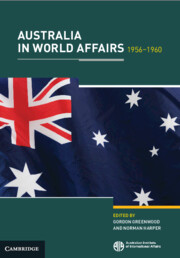Book contents
- Frontmatter
- Preface
- Contents and Contributors
- Maps
- I Australian Foreign Policy in Action
- II Perspective of Australia’s Overseas Economic Relations
- III The United Nations
- IV Australia and the United States
- V Australian Policy Towards Japan Since 1945
- VI Australia and Indonesia, 1945–60
- VII India
- VIII New Guinea and Nauru
- IX Australian Antarctic Territory
- Index
- Plates
V - Australian Policy Towards Japan Since 1945
Published online by Cambridge University Press: 29 March 2024
- Frontmatter
- Preface
- Contents and Contributors
- Maps
- I Australian Foreign Policy in Action
- II Perspective of Australia’s Overseas Economic Relations
- III The United Nations
- IV Australia and the United States
- V Australian Policy Towards Japan Since 1945
- VI Australia and Indonesia, 1945–60
- VII India
- VIII New Guinea and Nauru
- IX Australian Antarctic Territory
- Index
- Plates
Summary
Australian policy towards Japan has changed a great deal since Japan’s surrender. It has passed through three main phases. The first was the period of the early Occupation, from September 1945 to mid-1947. At this time Australian policy was mainly shaped by the emotional aftermath of the war years, by fear and bitterness. The overriding aim was security; to ensure that Japan would not again be able to return to the paths of aggression. This was linked with a demand for retribution, and a desire to make Japan into a democracy, since it was believed that a democracy by its nature seeks a peaceful and co-operative foreign policy. The transition to the second phase in 1947 was a reflection of the outbreak of the Cold War. The old fears of Japan were finding it harder to compete with the quickly growing fears of the Soviet Union and world Communism. From 1947 until 1951, when the Peace Treaty brought the Occupation to an end, Australian policy was ambivalent, or perhaps just inconsistent. How could Japan be made strong enough to be a bulwark against Communism, but not strong enough to be a possible danger again to Australia?
Keywords
- Type
- Chapter
- Information
- Australia in World Affairs 1956–1960 , pp. 243 - 271Publisher: Cambridge University PressFirst published in: 2024

